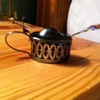Posted 12 years ago
 Militarist
Militarist
(295 items)
I am sure that most of us who took economics back in our school days can remember the graphs with supply and demand curves and how logical they made the determination of prices seem. However human nature is what creates demand and that can be most illogical and unpredictable especially in the collectables market. For example a 1914 Iron Cross Second Class with little or no intrinsic value can easily command 50.00 to 75.00 dollars in today’s market, even though it is a very common medal of which over 5,000,000 were made. On the other hand we have a Wisconsin National Guard Long Service Medal awarded from 1903 -1973 of which less than 5,000 were awarded. That makes the Wisconsin medal 1000 times rarer than the Iron Cross and yet it can purchased for only 15.00-20.00. Just goes to show that even the bad press that the Germans got is better than no press when it comes to collectibles.
















I always new wisconsin was special :-) Great post !!!! love it
oops that is "knew Wisconsin "
Very true but then again, 10 yrs ago both would bring more without considering the devaluation of the money.
Thanks Mani and blun. Respectfully disagree blunderbuss, ten years ago I think the Iron Cross was already 35.00-40.00 and the Wisconsin at 10.-15.
Militarist, the purchasing value 10 yrs ago of the dollar was considerably more. Governments call it inflation where others call it devaluation.
That is absolutely correct blunderuss. I was just thinking of the numbers of dollar on the price tags "without considering the devaluation of the money" as you said in comment number 3.
Thinking a bit more of rarity, prices and demand; anyone looking to expand their collecting fields may want to consider the local and state issued medals of their home state. Most, other than the current issues, are much scarcer than the medals of the popularly collected big three ( British, German and US) and prices are relatively cheaper due to weaker demand. To make things even more interesting collectors of local and state issued medals are in relatively uncharted waters. Even after 40+ years of collecting Wisconsin medals I still run across medals that I have never seen or heard of before!
Of course, you have shown many Wisconsin medals & I've found it interesting as I didn't previously know that states issued such medals. Was/is this common? In all the shows I have been to in yrs past, I don't remember them or maybe didn't notice them. Do you know how many states issued them and to whom?
I am sure that all the states and most of our territories have issued medals for their national guard units. Even the District of Columbia has. Some have issued many types of medals and others very few. I am sure that examples can be found at most gun and military shows but if you are like me you often don't "see" what you are not looking for. One of my happy hunting grounds for medals is ebay. There is a great book on state issued medals by Gregory Ogletree which is rare and hard to find, plus several smaller books on individual states; Colorado, Iowa, New York, New Jersey, Minnesota and Wisconsin, a new one which will be published shortly. Most cover only the state issues and a few mention some of the local issues. There are also two books out on the local issued WWI service medals of all the states. Most are out of print. None of the books with a very few examples get into the local company level and regimental medals issued mostly for marksmanship and drill. The new Wisconsin book will list a number of these that are known only due to collectors reporting them. Hope this answers some questions.
An interesting aspect of collecting which I didn't know existed. I don't live in the States but gives something to look out for. I love collecting & collectors. We all have a passion for our chosen fields. Since I've always tried to play the bumpin, is it true that the Italians made medals with German on 1 side & Eng. on the other? Don't want to ruin my reputation!
Keep on playing, you have me stumped on that one. Brings up another question: if the medal is in English on one side and German on the other... how do we know it is Italian?
That way they can flip it over depending on which side they are on that week. Obviously Italian.
I have always felt sorry for the Italians in WWII. They had a nut job dictator, just like the one he inspired to the north, that dragged them into a war that the Italians had no reason to get involved in. It is no wonder that their hearts were not in it.